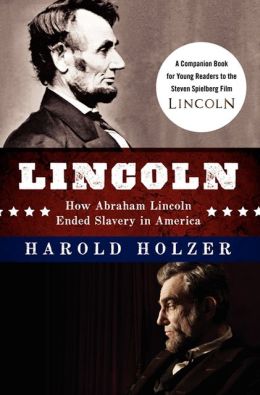
After watching the movie LINCOLN, directed by Steven Spielberg, my dad bought me the "Companion Book for Young Readers" by Harold Holzer entitled the lengthy; Lincoln: How Abraham Lincoln Ended Slavery in America.
One reason we learn history is so we know not to make the same mistakes as we did in the past. The same is true for the opposite. If we want to learn how to end slavery once and for all it is very helpful to see what worked in the past.
After spending so much time in class talking and learning about illegal modern slavery, it seemed fitting if not necessary to go back in time to see how slavery was first abolished in the United States.
The first gigantic moves against slavery in the United States occurred during Abraham Lincoln's presidency. First there was Abraham Lincoln and his Emancipation Proclamation which then lead to Abraham Lincoln and the 13th Amendment. Both topics the book goes thoroughly into detail on.
In chapter 9, the book explains what the Emancipation Proclamation was able to achieve, and also what its limits were. This proclamation ordered Union Troops to free slaves wherever they went within the South. African Americans were now welcomed into the Union military. Unfortunately, areas that were once Confederate and captured by the Union would not have to set their slaves free.
Not by accident, chapter 13 is on the topic of the 13th Amendment. This straightforward amendment was officially passed through Congress to truly enforce the message of the Emancipation. This was necessary because the Emancipation Proclamation was only reinforced by Abraham Lincoln, and he knew that it would be impossible to defend and enforce it successfully all by himself, even as the president. Now with this amendment, Congress has the power to reinforce it.
Abraham Lincoln was in no way alone on his endeavor. He had many people who stood by him, which allowed him to do what he did. All the voters, political endorsers, Union Troops, supporting family members, supporting Congress members, Fredrick Douglas, and Grace Bedell, and everyone else I am forgetting all played a part in the ending of legal slavery in the United States.
Using this old knowledge, the way towards ending slavery seems to be getting enough people on board to make an impact, free the slaves and making large acts against slavery. It worked once, so chances are it will work again.
Effect of 13th Amendment: http://ferrantedeanna.edublogs.org/2011/12/15/effect-and-implications/
Cover photo from: http://www.barnesandnoble.com/w/lincoln-harold-holzer/1113013110
I thought it was interesting that you used information from the past as an idea to end slavery in the present. I think it was clever to look back on how we once ended slavery so we can really end it now once and for all. It would have been good if there was mention if organizations or people that are trying to do some of these things to end slavery today.
ReplyDeleteI think that it was a wonderful idea to connect something that is such a big part of our past to our unit that teaches us about what kinds of slavery is going on today. I also thought that you did a lot of background research. It showed when you mentioned people who supported Lincoln and when you went into a lot of detail about the EMancipation Proclamation. I would challeng you to add soem more information about the present day slaves and ways we could help to end it.
ReplyDelete